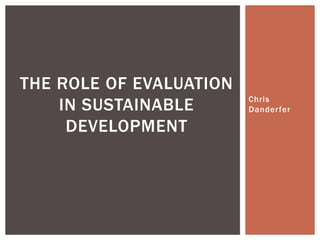
The Role of Evaluation in Sustainable Development
- 1. Chris Danderfer THE ROLE OF EVALUATION IN SUSTAINABLE DEVELOPMENT
- 2. What is Evaluation? Integration of Qualitative and Quantitative Methods. Style of Evaluation. Six Principles of Sustainable Development. Sustainable Development and Evaluation. A Local Example. Questions OVERVIEW
- 3. The classical definition of evaluation is “the determination of the value or worth of something…judged according to appropriate criteria, with those criteria explicated and justified” (House, 1993). This definition is an accurate description of some evaluation forms, especially in businesses. A more progressive definition states, “(Evaluation is) a form of applied research, where the researcher becomes a facilitator in helping those being studied to also become actively engaged in the quest for information and ideas to guide future efforts”(Sechrest & Sidani, 1995). WHAT IS EVALUATION?
- 4. To me, evaluation is a useful tool for helping communities or organizations understand what sustainable is in their specific context. Evaluation aids in connecting perceptions with potential realities. WHAT IS EVALUATION?
- 5. There exists a “…large body of evidence that shows conclusively how difficult it is to get accurate information about what is in people’s minds and how difficult it is to detect and deal with the cognitive biases of respondents and processors” (Sechrest & Sidani, 1995). We may assume that we know the truth, but we often don’t. “No such thing as an error-free method of inquiry exists. Moreover, it is difficult, sometimes impossible, to know even the direction of error…” (Rossman & Wilson, 1985). Despite attempts to minimize issues, quantitative and qualitative measures will have some degree of inaccuracy. INTEGRATION OF METHODS
- 6. Classical Evaluation: External evaluator, independent implementers. Focuses on objective, logical approaches using experimental and quasi-experimental designs. Partnership Evaluation: Collaboration between evaluators and local partners. Partners help design and conduct the evaluation. Participatory Evaluation: Based in the belief that knowledge is socially constructed and developed by the stakeholders. Attempts to increase utility of evaluation by increasing stakeholder participation. Naturalistic Evaluation: Change can best be assessed by observing stakeholders in their natural settings. Conscious participation is minimized. (Cummings, 2015) STYLE OF EVALUATION
- 7. 1. Harmony with nature: Development activities should support the essential cycles and life-support functions of ecosystems. 2. Liveable built environments: The quality of development should enhance fit between people and urban form. 3. Place-based economy: A local economy should strive to operate within natural system limits. 4. Equity: Equitable access to social and economic resources is essential. 5. Polluters pay: Interests that cause adverse community impacts bear the cost of their actions. 6. Responsible regionalism: Communities should not act in their interests to the detriment of others. (Berke & Conroy, 2000) PRINCIPLES OF SUSTAINABLE DEVELOPMENT
- 8. Sustainability requires “Reflexive scientific practice in order to enable the co-generation of solutions that account of uncertainty and multiple forms of knowledge” (Blackstock et al., 2006). Consideration must be given not only to beliefs and values held by communities and individuals, but also to the reality of the situation presented. “Qualitative research aims to provide an in-depth understanding of people’s experiences, perspectives, and histories in the context of personal circumstances” (Spencer et als., 2000). Evaluation can make explicit community values, beliefs, and personal values and biases. Assuming these things without evidence can be problematic. SUSTAINABILITY AND EVALUATION
- 9. The “Aim of inquiry is to answer some question or other. We conduct and inquiry when we are uncertain about something” (Sechrest & Sidani, 1995). We are largely unable to accurately determine whether sustainability exists. Perceptions are valuable, but may not be accurate. “True empowerment is based on strong organization of the …group, something that can happen only when all members are clear about their values and share a common vision of a better future” (Brunner & Guzman, 1989). Evaluation can reveal information about potential futures for the group, allowing them to make better informed decisions about a sustainable future. SUSTAINABILITY AND EVALUATION
- 10. I have been working with the Guelph-Wellington Business Enterprise Centre for the past few months conducting an internal process evaluation regarding leadership change. The following are significant: Change in management style Change in management gender Strong personal relationships Altered work environment Change in focus A LOCAL EXAMPLE
- 11. My family is from a farm in rural Saskatchewan. The nearest town is Biggar, about 15-20 minutes away. While the population is remaining stable, there are a number of less obvious issues facing the town. If you asked some of the townspeople, many would say that to become sustainable the community would need to find a way to restore factors (jobs, businesses, farms, etc…) that had disappeared over the last 20 years. If you asked council members, they might suggest a different path forward. Returning to a previous state, which is unlikely to be possible, would only delay the degradation of the community. Evaluation can help consolidate the views and wishes of the community with the reality of the situation they face. A SECOND EXAMPLE
- 12. How might evaluation hamper sustainable development? How does evaluation differ from research? Does it differ? How can we consolidate people’s perceptions with the information generated through evaluative programs? QUESTIONS
- 13. Berke, P., and Conroy, M. (2000). Are we planning for sustainable development? Journal of the American Planning Association, 66(1), 21-33. Blackstock, K., Kelly, G., & Horsey, B. (2007). Developing and applying a framework to evaluate participatory research for sustainability. Ecological Economics, 60, 726-742. Garaway, G. (1995). Participatory evaluation. Studies in Educational Evaluation, 21, 85-102. Guzman, A., and Brunner, I. (1989). Participatory evaluation: A tool to asses projects and empower people. International Innovations in Evaluation Methodology, 42, 9-18. Sechrest, L., and Sidani, S. (1995). Quantitative and qualitative methods: Is there an alternative? Evaluation and Program Planning, 18(1), 77- 87. Spencer L., Lewis, J., Ritchie, J., & Dillon, L. (2003). Quality in qualitative evaluation: A framework for assessing research evidence. National Centre for Social Research, 1-17. REFERENCES